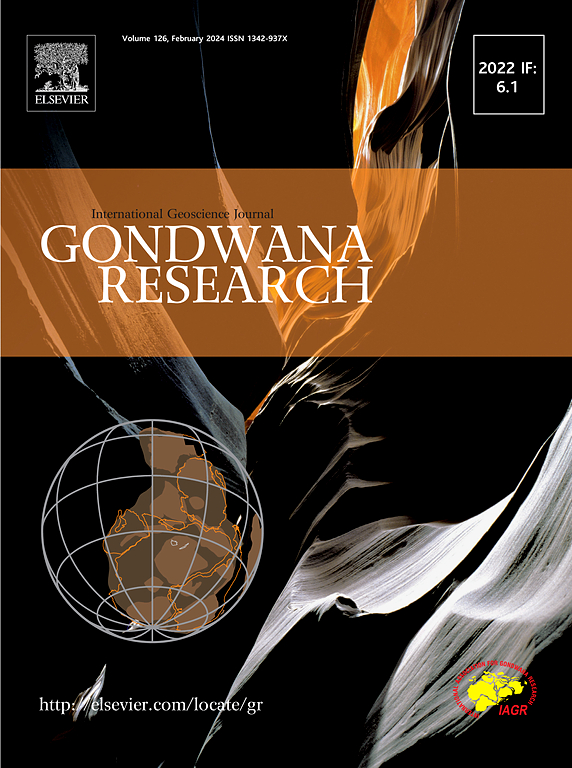A vertical reverse zoning in the Kunshan W-Mo-Cu deposit, South China: Insights from mineral paragenesis, zircon geochemistry and S-Pb-O isotopes
IF 7.2
1区 地球科学
Q1 GEOSCIENCES, MULTIDISCIPLINARY
引用次数: 0
Abstract
The identification of reverse zoning in tungsten deposits is crucial, as it represents an atypical distribution of orebodies that may affect exploration and mining strategies. However, the exploration of such deposits remains challengeable due to uncertainties regarding the parageneses of polymetallic mineralization, the upper temperature limit of the formation of wolframite, and the evolutionary path of fluids, all of which influence the patterns of the distribution of ore mineralization. Recently, we have found that the Kunshan W-Mo-Cu deposit situated within the world-class Dahutang tungsten ore district in the middle segment of the Jiangnan Orogen, South China, is special for the vertical reverse zoning of W-Mo-Cu paragenetic mineralization. To trace the evolutionary paths of magmatic and deuteric hydrothermal fluids, estimate the redox conditions of magma crystallization, and determine the sources and temperatures of ore-forming fluids, we conducted a comprehensive study of the geochemical compositions of zircons and the S-Pb-O isotope systematics of quartz, wolframite and sulfide. We investigated the relationships between trace elements, oxygen fugacity (ƒO2) and W-Mo-Cu parageneses, as well as the degree of contamination of parental magma by overlying metasediments. Our results indicate that the paragenetic W-Mo-Cu mineralization was triggered by a moderately reduced initial magma (ΔFMQ = −0.55 ∼ -0.20) containing 41 % meta-igneous-dominated component (δ18Omagma = +9.2 ‰) and metasediments (δ18OWR = +12.6 ‰). The vertical reverse zoning is characterized by proximal Cu mineralization located beneath the distal high-temperature (394 °C) tungsten mineralization zone and was formed by volatile-rich fluids within an open metallogenic system. We argue that the exploration of deposits with vertical reverse zoning should continue, despite the decrease in the grade of tungsten ore with depth, while the content of metal sulfides may likewise increase.

昆山钨钼铜矿床的垂直逆分带:矿物共生、锆石地球化学和S-Pb-O同位素的启示
确定钨矿床的反向分带至关重要,因为它代表了矿体的非典型分布,可能会影响勘探和采矿战略。然而,由于多金属成矿的副成因、黑钨矿形成的温度上限以及流体的演化路径存在不确定性,这些因素都会影响矿石成矿的分布模式,因此这类矿床的勘探工作仍然面临挑战。最近,我们发现,位于中国南方江南造山带中段世界级大湖塘钨矿区内的昆山钨钼铜矿床,其钨钼铜副成矿作用的垂直反向分带具有特殊性。为了追溯岩浆和氘热液的演化路径,估算岩浆结晶的氧化还原条件,确定成矿流体的来源和温度,我们对锆石的地球化学组成以及石英、黑钨矿和硫化物的S-Pb-O同位素系统学进行了全面研究。我们研究了微量元素、氧富集度(ƒO2)和W-Mo-Cu副成因之间的关系,以及母岩浆被上覆变质岩污染的程度。我们的研究结果表明,W-Mo-Cu 的成矿作用是由中度还原的初始岩浆(ΔFMQ = -0.55 ∼ -0.20)引发的,该岩浆含有 41% 的元火成岩成分(δ18Omagma = +9.2‰)和玄武岩成分(δ18OWR = +12.6‰)。垂直反向分带的特点是近端铜矿化位于远端高温(394 °C)钨矿化带之下,由开放成矿系统中的富挥发性流体形成。我们认为,尽管钨矿的品位会随深度的增加而降低,而金属硫化物的含量也会增加,但仍应继续勘探具有垂直反向分带的矿床。
本文章由计算机程序翻译,如有差异,请以英文原文为准。
求助全文
约1分钟内获得全文
求助全文
来源期刊

Gondwana Research
地学-地球科学综合
CiteScore
12.90
自引率
6.60%
发文量
298
审稿时长
65 days
期刊介绍:
Gondwana Research (GR) is an International Journal aimed to promote high quality research publications on all topics related to solid Earth, particularly with reference to the origin and evolution of continents, continental assemblies and their resources. GR is an "all earth science" journal with no restrictions on geological time, terrane or theme and covers a wide spectrum of topics in geosciences such as geology, geomorphology, palaeontology, structure, petrology, geochemistry, stable isotopes, geochronology, economic geology, exploration geology, engineering geology, geophysics, and environmental geology among other themes, and provides an appropriate forum to integrate studies from different disciplines and different terrains. In addition to regular articles and thematic issues, the journal invites high profile state-of-the-art reviews on thrust area topics for its column, ''GR FOCUS''. Focus articles include short biographies and photographs of the authors. Short articles (within ten printed pages) for rapid publication reporting important discoveries or innovative models of global interest will be considered under the category ''GR LETTERS''.
 求助内容:
求助内容: 应助结果提醒方式:
应助结果提醒方式:


